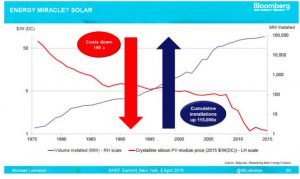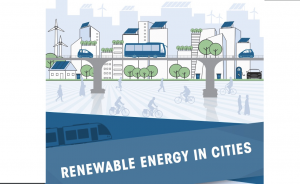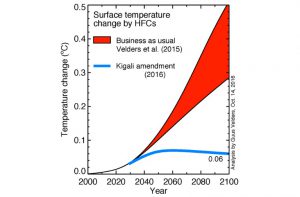.. SUSTAINABLE DEVELOPMENT ..
An article by Joe Romm in Think Progress (abbreviated)
Solar energy has grown 100-fold in this country [USA] in the past decade. Globally, solar has doubled seven times since 2000, and Dubai received a bid recently for 800 megawatts of solar at a stunning “US 2.99 cents per kilowatt hour” — unsubsidized! For context, the average residential price for electricity in the United States is 12 cents per kilowatt-hour.

Solar’s exponentially declining costs and exponentially rising installations
(the y-axis is a logarithmic scale).
(Click on image to enlarge)
Solar energy has been advancing considerably faster than anyone expected just a few years ago thanks to aggressive market-based deployment efforts around the globe. Since it’s hard to keep up with the speed-of-light changes, and this is the fuel that will power more and more of the global economy in the near future, here are all the latest charts and facts to understand it. If you are looking for one chart to sum up the whole solar energy miracle, Bloomberg New Energy Finance (BNEF) Chairman Michael Liebreich has one from his keynote address at BNEF’s annual conference in April titled “In Search of the Miraculous” [see chart above]:
Thanks to sustained long-term deployment programs, Liebreich explained, “We’ve seen the costs come down by a factor of 150 since 1975. We’ve seen volume up by 115,000.” “How much more miracle-y do you need your miracles to be,” Liebreich added.
What that chart doesn’t reveal is that the price drop and the sales volume increase are directly linked. There is a learning curve: Over the past four decades, for every doubling in scale of the solar industry, the price of solar modules has dropped roughly 26 percent. . .
BNEF projects that by 2040, the world will invest an astonishing $3.4 trillion in solar. That’s more than the projected cumulative investment of $2.1 trillion for all fossil fuels — and $1.1 trillion in new nuclear — combined.
The result of these investments and the continued learning by solar (and wind) makes “these two technologies the cheapest ways of producing electricity in many countries during the 2020s and in most of the world in the 2030s. . . ”
This year we learned “City of Palo Alto considers solar power contract at under $37/MWh.” Bloomberg reported last week that “Berkshire Hathaway Inc.’s NV Energy agreed to pay 3.87 cents a kilowatt-hour for power from a 100-megawatt project that First Solar Inc. is developing.”
It is worth remembering that U.S. solar power bids include the 30 percent Investment Tax Credit. According to one analysis, NV Energy’s “$.0387/kWh would potentially turn into about $.07/kWh if we backed out the 30% Federal Tax Credit and 60% depreciation in Year One.”
The bids seen around the world this year without subsidies or incentives are even more stunning. Dubai Electricity and Water Authority (DEWA) received a bid this year for 800 megawatts at a jaw-dropping “US 2.99 cents per kilowatt hour.”
Two other bids were below US 4 cents/kWh, and the last two bids were both below 4.5 cents/kWh — again all of these bids were without subsidies!
That 2.99 cents bid is way down from a 2015 deal Dubai signed for more than 1000 megawatts at 5.84 cents over 25 years. So Dubai has seen a 50 percent price drop in solar in just 18 months.
(Continued on right side of page)
Question for this article:
Are we making progress in renewable energy?
(Article continued from left side of page)
And these prices aren’t unique to the Middle East. As Bloomberg New Energy Finance reported in April, Enel Green power signed a contract for $.036/kWh in in Mexico — 3.6 cents.
With prices dropping so fast, sales of solar PV [photovoltaic] systems have been soaring, as you can imagine.
From 2005 through 2015, annual PV sales in this country went up 100-fold! And projections suggest that solar sales may double this year, driven by Congress’s five-year renewal (with phase-out) of the solar Investment Tax Credit (ITC). . .
The solar miracle has been driven by major state, national, and international policies. BNEF Chair Liebreich calls this “The March of the Price Signal” — the rapid expansion of global deployment programs, especially market-based mechanisms such as renewable portfolio standards and reverse auctions.
Unfortunately, other countries have had bigger and more reliable deployment programs whereas our erratic policies generally diminish or disappear whenever and wherever conservatives assume control. In the past decade in particular, massive government-led deployment policies in China and Germany have been a major driver of the world’s stunning price drop.
The good news is that solar power in this country has a very bright future, thanks to the renewal of the ITC. By one recent projection, the U.S. could hit 100 gigawatts total installed capacity by 2021. That said, India also plans to hit 100 gigawatts by 2022.
China, however, plans to triple solar PV capacity to 150 gigawatts installed by 2020! So the race is definitely on.
No wonder the International Energy Agency concluded last fall: “Driven by continued policy support, renewables account for half of additional global generation, overtaking coal around 2030 to become the largest power source.”
The ‘Other’ Form Of Solar Energy, Which Can Run At Night
Earlier this month, I wrote about the “other” form of solar, concentrating solar thermal power, which uses sunlight to heat water and uses the steam to drive a turbine and generator. That heat can be stored over 20 times more cheaply than electricity — and much more efficiently — so CSP [Concentrated Solar Power] can provide power long after the sun has gone down.
Now that China appears to be placing a large bet on solar thermal electric, it seems likely CSP will also start coming down the learning curve, which will help it increase sales, which in turn will keep it coming down the learning curve — a virtuous circle that PV is already benefiting from.
The 2014 STE Technology Roadmap from the International Energy Agency (IEA) projected that while PV could generate 16 percent of the world’s electricity by 2050, as much as 11 percent could be generated by STE [solar thermal energy] at the same time.
Given how fast solar PV has been coming down in price — and given the world’s commitment in Paris last December to keep ratcheting down carbon pollution in the coming decades to keep total global warming “well below 2°C” — it seems entirely possible if not likely that solar power will outperform the IEA’s scenario.
Indeed, it’s precisely because clean energy has been moving at the speed of light that “almost everything you know about climate change solutions is probably outdated,” as I’ve been detailing for months. Stay tuned to this channel for more surprises.
(Thank you to Janet Hudgins, the CPNN reporter for this article.)









